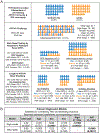Nasal and systemic immune responses correlate with viral shedding after influenza challenge in people with complex preexisting immunity
- PMID: 40768601
- PMCID: PMC12375958
- DOI: 10.1126/scitranslmed.adt1452
Nasal and systemic immune responses correlate with viral shedding after influenza challenge in people with complex preexisting immunity
Abstract
Each year in the United States, ~50% of adults ≥18 years old are vaccinated against influenza viruses, with protective efficacy averaging 40.5% over the past 20 years. To model annual seasonal influenza, a cohort of 74 adults, who were unscreened for preexisting A/H1N1 immunity and half of whom were recently immunized with licensed QIV (mean of 64 days), were challenged with A/H1N1 influenza virus. Transcriptomic, proteomic, and VDJ repertoire analyses were performed on nasal and peripheral blood samples from participants to identify nasal mucosal and systemic immune responses that correlated with viral shedding and immune correlates of protection. Viral-shedding participants showed increased T cell, but not B cell, VDJ diversity with expansion of low-frequency B cell clones postchallenge, including broadly neutralizing motifs. Nonshedding participants demonstrated decreased clonality and increased richness of B and T cell VDJ clones, increased preinoculation nasal mucosal immune gene and serum protein expression, and increased ex vivo peripheral blood mononuclear cell responses. Nasal mucosal responses in participants shedding virus for 2 or more days showed higher early viral loads and exhibited stronger induction of antiviral responses compared with those in participants who shed virus for 1 day. Last, participants with a single day of viral shedding were three times more likely to be female. These data shed light on the complex immune responses in the nasal mucosa and the periphery after influenza vaccination and infection, which will be critical for next-generation vaccine development.
Figures






References
-
- C. f. D. Control. (Center for Disease Control, https://www.cdc.gov/flu-burden/php/about/index.html, 2024), vol. 2024.
-
- Iuliano AD, Roguski KM, Chang HH, Muscatello DJ, Palekar R, Tempia S, Cohen C, Gran JM, Schanzer D, Cowling BJ, Wu P, Kyncl J, Ang LW, Park M, Redlberger-Fritz M, Yu H, Espenhain L, Krishnan A, Emukule G, van Asten L, Pereira da Silva S, Aungkulanon S, Buchholz U, Widdowson MA, Bresee JS, Estimates of global seasonal influenza-associated respiratory mortality: a modelling study. Lancet 391, 1285–1300 (2018). - PMC - PubMed
MeSH terms
Substances
Grants and funding
LinkOut - more resources
Full Text Sources
Medical
Miscellaneous

